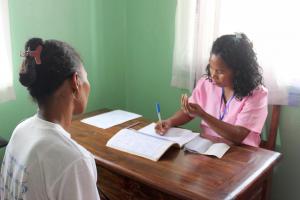Low-tech screening expands cervical cancer diagnosis in Madagascar
Antananarivo, 4 February 2019 – She waited anxiously for a check-up at a local clinic. Merely a minute after being examined, Gisele* received the result of her cervical cancer test. Up to 8000 women are tested every year, mostly through a community-based screening programme in Madagascar, where cervical cancer is the deadliest type of cancer among women.
A brief counselling preceded Gisele’s testing at Ambalavato health centre in Antsirabe 1 district, some 170 km south of the capital Antananarivo. The mother of four said she had felt something unusual, but a previous consultation elsewhere was not conclusive. So she sought another check-up. Midwife Ioby Ranarison, in charge of cervical cancer testing at Ambalavato, said most of the women who turn up for testing are either referred by a physician or because of family history of cervical cancer.
The screening test – Visual Inspection with Acetic Acid (VIA) – is a simple, inexpensive method that can be offered in low-income areas. It does not require heavy technical investment such as a lab or sophisticated analysis. The screening is a visual check for abnormal tissue appearance when acetic acid solution is applied on the cervix. Test results are immediate and reliable. Diagnosing the disease early and effective treatment can cut cervical cancer mortality for which Africa bears the greatest burden globally.
“I am happy to know my health status. I was so worried because I did not know what was happening to me, and now I feel like a burden has been lifted off me,” said Gisele.
To encourage more women to get diagnosed, health authorities in Madagascar organize periodic mass testing campaigns. On such occasions, Ms Ranarison said, up to 40 women can take the test in a day at the clinic. While not an overwhelming turn-out, she pointed out that “it gives us great satisfaction that they want to know their health status.”
Casting the net wide
In 2007, Madagascar introduced a community-based cervical cancer screening programme. However, so far only 140 out of the country’s 2500 local health centres provide the testing in 12 of 114 districts. Consultation costs 25 US cents. The World Health Organization and a few partner agencies are supporting the Ministry of Health’s cervical cancer community-based testing. It costs between US $10 000 and $ 15 000 to set up the testing programme per district. The cost comprises basic equipment, supplies and health worker training.
A positive visual test does not necessarily mean that one has cervical cancer, but shows precancerous signs that can be treated depending on the state of advancement.
Baptistine*, one of the first women to get tested when the programme was launched, recounted that she was filled with fear when she went for screening. “Knowing one’s health status is reassuring,” said Baptistine. She took a second test two years later, and said she encouraged her sister to do the same.
One of the main impediments to expanding the community-based screening is inadequate funding. Dr Lovatianaharisoa Fetinjanahary, who heads the cervical cancer screening programme at the Health Ministry, said that public education was being conducted only during health worker trainings or screening campaigns due to the limited number of health centres offering the service. More efforts are needed to increase the number of women tested for cervical cancer. Currently, only 4% of the women targeted in the selected districts are being tested. The national goal is to screen 25% of women aged 25 – 49 years old.
*Pseudonym used to protect privacy



